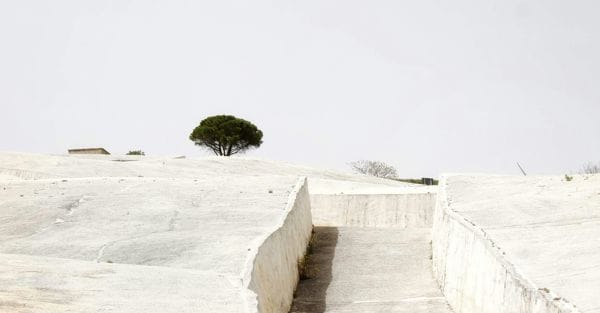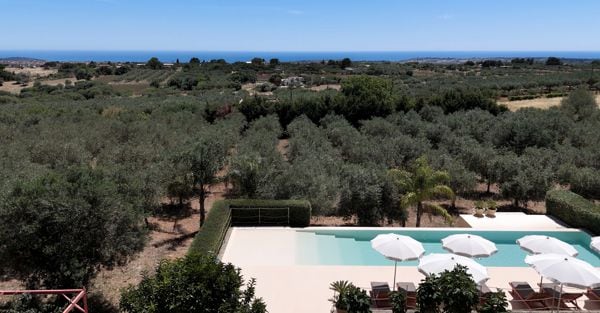Beyond the sea, explorations in the quiet countryside of Sicily

Piero Guccione loved the moody sea of the province of Ragusa. Throughout his life he painted it, sometimes trying to capture its calm immobility, other times its thunderous anger, as can be seen in his splendid oils exhibited in the new Piero Rooms, in Scicli where he has also just inaugurated the Carmine Museum of Contemporary Art. There was not a day in which he did not go for a walk on the beach of Sampieri, two kilometers to the old Pisciotto furnace with the chimney now halved. The other painters of the Scicli Group, of which he was the leader with Franco Sarnari, preferred to paint the countryside. That countryside that in spring is an exuberant green and in summer paints the hinterland with gold. Yellow, ochre, brown, hedges of prickly pears, almond trees and carob trees with twisted trunks that emerge from that parched earth like desperate souls. Courtyards, sunny terraces, doors closed until eight in the evening, when the light finally gives a break and leaves a glimmer of freshness. In those paintings you can almost smell the scent of jasmine and the chirping of cicadas, they are so real.
The Sicilian hinterland is mysterious, a masterpiece of nature and man who has traced the borders with dry stone walls, and each plot is a story of small producers and noble estates, where cheeses and ricottas, cured meats and sausages, gold medal-winning oil and wine are born. It seems that the sleeping beauty has finally woken up after centuries and suddenly wants to tell her stories.

The hunger for more authentic tourism has put Sicily in the spotlight, and here it is announcing ambitious renovation projects in the name of its proverbial hospitality. Big groups have occupied the coast, such as Belmond and more recently Four Seasons which, with the series “The White Lotus” has caused Taormina to sell out in the last two years. While Rocco Forte, after two successful outposts on the sea – Verdura in Sciacca and Villa Igiea in Palermo – is transforming the eighteenth-century Palazzo Castelluccio in Noto into a new five-star hotel expected in 2026. A satellite of stylists and creatives who have found their corner of paradise there and a film set location for their social events, Noto is now a star, beautiful and already too famous. But you only need to move a little to find places and atmospheres far from fashion. In the countryside overlooking the sea of Avola, Braccialieri opened in April, four rooms in the historic farmhouse and six eco villas scattered across an estate of 2,200 olive trees and 250 almond trees. On one side the agricultural project, on the other the small hotel curated by the explosive Alessandro Enriquez for the Cancemi family. The highlight is the red and white checkered swimming pool with the writing “Don't forget to love” on the bottom, surrounded by deckchairs and umbrellas with red geraniums, in addition to the wallpaper with lemons and mandarins and the dinner services with the theme of the project: love for Sicily and for life in general. In that little world that churns out parmigiana and serves granita to taste, you feel like you are at the home of relatives or friends. You don't miss the sea, which can be reached by sight, before arriving at the beach club owned by the property. The Occhipinti sisters have instead given a good shake to the province of Ragusa, among the most reticent to make itself known. Arianna, an oenologist, with her cellar of amazing wines in Vittoria, and Fausta, an architect and landscaper, with Baglio Occhipinti, a thriving farm with vegetable gardens and charming rooms nearby. The main activity is relaxation, alternated with cooking lessons, pastry making, painting, and straw coffee decoration. But this is just a taste.

The slow and rural holiday is a passion for travellers and is growing across the island from east to west. In the hinterland of Menfi, in 2024 La Segreta opened, the country house of the Planeta family, producers of excellent oil and wine that are exported all over the world. Ten rooms of monastic simplicity in which to isolate yourself from everything, with the comfort of a swimming pool and the home cooking of Angelo Pumilia, also chef of the nearby Foresteria immersed in a garden of herbs and of the beach club Insula soon after. Here too, slow life prevails, but the location is strategic for exploring one of the most silent corners of the island, from the archaeological excavations of Selinunte to the contemporary surrealism of Alberto Burri's Cretto, the largest work of land art in Europe. This masterpiece is located in the Belice valley that in 1968 a 6.4 earthquake shook, crumbling the houses like shortcrust pastry biscuits. The foundations remained there, a visceral wound, until 1981, when Ludovico Corrao, an enlightened mayor, opened a competition for some artists to transform the site into a memorial, in continuity with the Museum of Contemporary Art (Mac) that he had created in the new city, 11 kilometers away. Among all, Burri's idea of reconstructing the three-dimensional map of the village with the checkerboard of blocks and the intertwining of streets with rubble and concrete won. From afar, the impression is of a gigantic white shroud lying in a landscape of hills. There is no entrance ticket, nor a caption or an enclosure. More frequented by flocks than by people, it is an extraordinary public heritage that, together with the 400 works of the Mac in the new city, have earned Gibellina the nomination, for 2026, as the first Italian Capital of Contemporary Art, with the allocation of one million euros to invest in cultural and redevelopment activities.

There is no shortage of projects, a new energy runs through Sicily, which has not focused entirely on seaside resorts, but on its interior enhanced by local businesses with a contemporary vision, by important awards such as Agrigento Italian Capital of Culture 2025, by film productions such as “The Leopard” recently distributed by Netflix, where the countryside is a crucial element of the narrative: Donnafugata, the Calanchi di Cannizzola, Ciminna have well rendered the atmosphere of the novel by Tomasi di Lampedusa and with their charm have sparked curiosity about a nearby yet so exotic destination.
ilsole24ore




